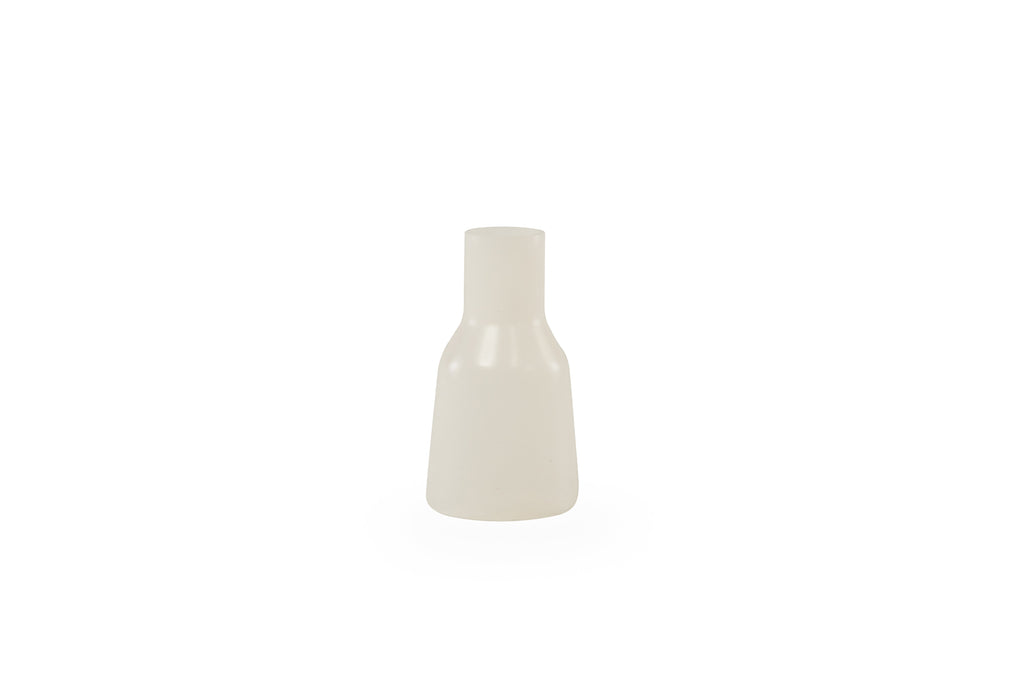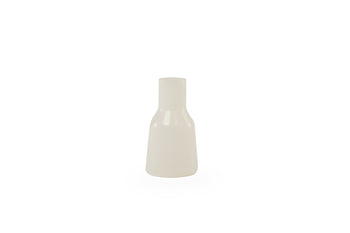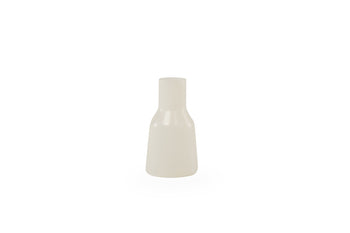
TUNAIR™ Baffled Flask – High-Performance Erlenmeyer Flask for Optimized Aeration
The TUNAIR™ polypropylene Erlenmeyer flask system is a revolutionary solution designed for microbiology and biotechnology applications. Unlike traditional flasks, the TUNAIR™ baffled flask system enhances oxygen transfer rates, creating ideal growth conditions for aerobic microorganisms, mammalian cells, and plant cells. With its patented closure and innovative baffle design, this system ensures optimal aeration, making it a superior choice for researchers focused on maximizing culture yields and productivity.
Enhanced Culture Growth with a Patented Baffling System
The TUNAIR™ baffled flask provides significant advantages over standard Erlenmeyer flasks by improving oxygen absorption and nutrient mixing. The unique baffle system within the flask disrupts liquid movement, creating turbulence that enhances aeration and maximizes dissolved oxygen levels. This allows for improved microbial respiration and cell metabolism, leading to higher cell densities and faster growth rates. The baffled flask design also promotes better heat dissipation, reducing the risk of localized overheating, which can negatively affect cell viability and overall culture performance.
The Half-Baffle Shake Flask variant of the TUNAIR™ system is specifically engineered with two baffles that produce a vortex motion within the culture media. This vortex effect further enhances oxygen exchange and facilitates uniform mixing of nutrients, promoting healthier and more robust cell growth. With a working volume of 100 ml, this flask is an excellent choice for small to mid-scale culture applications that require controlled aeration.
Durable and Chemically Resistant Polypropylene Construction
Each TUNAIR™ Erlenmeyer flask is constructed from high-quality polypropylene, a material known for its durability and resistance to most solvents. The polypropylene composition ensures that the flask maintains structural integrity even after repeated autoclaving and exposure to a variety of chemical reagents. This makes it a cost-effective and reliable solution for laboratories requiring long-term performance from their culture vessels.
The TUNAIR™ baffled flask is designed for easy handling, with smooth, rounded edges that provide a comfortable grip. The sturdy polypropylene walls offer excellent resistance to breakage, making these flasks safer to use in busy lab environments compared to glass alternatives. Additionally, their lightweight nature reduces strain when handling multiple flasks during large-scale experiments.
Simple Cleaning and Maintenance for Repeated Use
TUNAIR™ flasks are designed for easy maintenance and reuse. Cleaning these baffled flasks is simple and efficient. They can be soaked in water with a mild detergent solution to loosen contaminants, then thoroughly rinsed and air-dried before reuse. This straightforward cleaning process ensures that flasks remain free from residual biological material, reducing the risk of cross-contamination between experiments. Autoclaving the flasks before each use further enhances sterility and ensures that cultures remain free from unwanted microbial interference.
Compatible with a Variety of Closure Systems
The TUNAIR™ Erlenmeyer flask system features a patented closure design that enhances gas exchange while maintaining sterility. This turbo-vane closure system works in conjunction with the flask’s baffle design to provide a controlled, oxygen-rich environment for cultures. The caps and filters for these flasks are available separately, allowing researchers to customize their setups based on specific experimental needs. Whether working with aerobic bacteria, yeast, or cell culture systems, the TUNAIR™ closure system helps maintain optimal growth conditions while minimizing contamination risks.
Ideal for a Wide Range of Microbial and Biotechnological Applications
The TUNAIR™ baffled flask is widely used across various disciplines of microbiology and biotechnology due to its superior aeration capabilities. It is ideal for applications requiring high oxygen transfer rates, including fermentation, recombinant protein production, and enzyme expression studies. Researchers working with mammalian cells and plant cell cultures also benefit from the improved oxygenation provided by these flasks, ensuring that their cultures achieve maximum viability and productivity.
This Erlenmeyer flask system is also used in industrial biotechnology for the production of biofuels, antibiotics, and other biologically derived compounds. The efficient mixing and aeration properties of the baffled flask make it a valuable tool for optimizing cell growth and metabolic activity, ultimately leading to higher product yields and improved process efficiencies.
Limited Time Offer – 25% Off TUNAIR™ Baffled Flasks
For a limited time, the TUNAIR™ baffled flask system is available at a 25% discount. This is the perfect opportunity for laboratories and research institutions to upgrade their culture systems with high-performance Erlenmeyer flasks designed for enhanced aeration and growth optimization. Take advantage of this exclusive offer and experience the benefits of improved oxygen transfer, enhanced culture yields, and durable polypropylene construction.
The TUNAIR™ baffled flask is an essential tool for researchers looking to maximize cell growth and metabolic efficiency in microbiological and biotechnological applications. With its innovative baffle system, high-quality polypropylene construction, and compatibility with specialized closure systems, this Erlenmeyer flask sets the standard for advanced culture techniques. Order now and elevate your research with superior aeration and enhanced culture productivity.
- Accessories
- Specifications
- Technical Information
Flask Dimensions:
Flask Size: 300 ml Working Volume: 100 ml Base Diameter: 3.25” [8.25 cm] Neck Diameter: 1.75” [4.45 cm] Height: 6.00” [15.24 cm] Weight: 0.01 lbs. [0.004 Kg]Cell Growth Evaluation of Commonly Used Shake Flasks:
TUNAIR™ flasks were compared to conventional flasks using four different types of microorganisms;Escherichia coli,Saccharomyces cerevisiae, Penicillium avellaneum, and Streptomyces chartreusis. The aeration capacities of the shake flasks were determined by the sulfate oxidation method, and the values shown below are presented as oxygen absorption rate (OAR) in mM oxygen/L/Min. The growth rates of E.coliandS.cerevisiae were expressed as optical densities (OD) at 555 mM. For S.chartreusis and P.avellaneum growth rates were evaluated by percent sedimentation. For E.coli and S.cerevisiae, the growth rates were determined after an 18-hour incubation period; for S.charteusis, a 24-hour incubation period; and for P.avellaneum, a 72-hour incubation period. Growth and OAR evaluations were carried out with 3-9 replicates and statistically analyzed using Turkey’s w-procedure. See results below.
Growth Chart:
| OAR Value | OD @ 555 mM | % Sedimentation | |||
|---|---|---|---|---|---|
| Flask | mM O2/L/Min. | E.coli | S.cerevisiae | S.chartreusis | P.aveilaneum |
| TUNAIR™ Full-Baffle | 4.25 | 7.09 | 5.63 | 19.7 | 3.3 M |
| TUNAIR™ Half-Baffle | 1.22 | 5.36 | 5.57 | 27.73 | 30.50 P |
| Triple Indented Flasks | 2.47 | 5.97 | 5.31 | 19.20 | 9.50 MP |
| Unbaffled Erlenmeyer | 0.52 | 5.97 | 5.19 | 17.37 | 25.10 P |
Growth Morphology:
M, mycelial; P, pellet; MP, mixed mycelial. The mycelial growths mostly adhered to the walls of the flask, which accounted for the low overall sedimentation value.
Growth Comparison of Saccharomyces Cerevisiaein TUNAIR™ Shake Flasks and Brand C Shake Flasks:
The experiment was done on a New Brunswick INNOVA 44 shaker incubator.
It was conducted at different speeds – 200 rpm & 300 rpm.
Strain: Saccharomyces Cerevisiae
Medium: YPD broth (Yeast Extract Peptone Dextrose)
Flasks: IBI TUNAIR™ 300 ml Flask and Brand C 250 ml Growth Flasks
Cell Analyzer: Vi-Cell XR
Experiment Summary:
In this experiment, standard volume--60 & 50 ml YPD--was used for TUNAIR™ and Brand C flasks, which is 20% capacity of the flasks. The flasks were incubated at 30°C at speeds of 200 rpm and 300 rpm for 28 hours. After taking viable cell counts, it was found that under low speed (200 rpm) both TUNAIR™ and Brand C flasks contained yeast cultures of higher cell densities when compared to the higher speed (300 rpm) cell culture flasks.
It was also noted that the TUNAIR™ flask had higher cell density at 200 rpm and 300 rpm when compared to the Brand C flask. Although these data indicate TUNAIR™ flasks support higher density cell growth, we expected that higher speed (rpm) should produce higher cell density due to the higher dissolved oxygen concentration and better dispersion of cells. This unexpected data might be due to frozen cell culture stock, which might take a longer time to adapt to the environment. More experiments are required and are being carried out at this time.
The focus of these experiments will involve:
• Varying shaker speeds and varying volumes of medium
in the TUNAIR™ and Brand C flasks
• Comparative studies between TUNAIR™ 2.5-L growth flasks
and Brand C 2-L flasks
• Varying shaker speeds and varying volumes of medium in the larger TUNAIR (2.5 L) and larger Brand C (2 L) flasks
Reference Papers:
1. Method to Increase the Yield of Eukaryotic Membrane Protein Expression in Saccharomyces Cerevisiae
2. Optimisation of Recombinant Production of Active Human Cardiac SERCA2a ATPase
3. Analysis of Various Bioreactor Configurations for Heavy Metal Removal Using the Fungus Penicillin Ochro-Chloron








